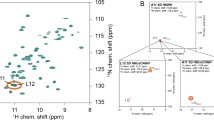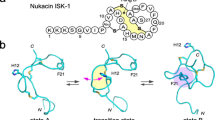Abstract
In protein NMR experiments which employ nonnative labeling, incomplete enrichment is often associated with inhomogeneous line broadening due to the presence of multiple labeled species. We investigate the merits of fractional enrichment strategies using a monofluorinated phenylalanine species, where resolution is dramatically improved over that achieved by complete enrichment. In NMR studies of calmodulin, a 148 residue calcium binding protein, 19F and 1H-15N HSQC spectra reveal a significant extent of line broadening and the appearance of minor conformers in the presence of complete (>95%) 3-fluorophenylalanine labeling. The effects of varying levels of enrichment of 3-fluorophenylalanine (i.e. between 3 and >95%) were further studied by 19F and 1H-15N HSQC spectra,15N T1 and T2 relaxation measurements, 19F T2 relaxation, translational diffusion and heat denaturation experiments via circular dichroism. Our results show that while several properties, including translational diffusion and thermal stability show little variation between non-fluorinated and >95% 19F labeled samples, 19F and 1H-15N HSQC spectra show significant improvements in line widths and resolution at or below 76% enrichment. Moreover, high levels of fluorination (>80%) appear to increase protein disorder as evidenced by backbone 15N dynamics. In this study, reasonable signal to noise can be achieved between 60–76% 19F enrichment, without any detectable perturbations from labeling.



Similar content being viewed by others
Abbreviations
- 3-FPhe:
-
3-fluorophenylalanine
- CaM:
-
Calmodulin
- NMR:
-
Nuclear magnetic resonance
References
Akcay G, Kumar K (2009) A new paradigm for protein design and biological self-assembly. J Fluor Chem 130:1178–1182
Altieri AS, Hinton DP, Byrd RA (1995) Association of biomolecular systems via pulsed-field gradient Nmr self-diffusion measurements. J Am Chem Soc 117:7566–7567
Anderluh G, Razpotnik A, Podlesek Z, Macek P, Separovic F, Norton RS (2005) Interaction of the eukaryotic pore-forming cytolysin equinatoxin ii with model membranes: F-19 Nmr studies. J Mol Biol 347:27–39
Bann JG, Pinkner J, Hultgren SJ, Frieden C (2002) Real-time and equilibrium F-19-Nmr studies reveal the role of domain-domain interactions in the folding of the chaperone papd. Proc Natl Acad Sci USA 99:709–714
Barbato G, Ikura M, Kay LE, Pastor RW, Bax A (1992) Backbone dynamics of calmodulin studied by N-15 relaxation using inverse detected 2-dimensional Nmr-spectroscopy-the central Helix is flexible. Biochemistry 31:5269–5278
Bilgiçer B, Fichera A, Kumar K (2001) A coiled coil with a fluorous core. J Am Chem Soc 123:4393–4399
Broos J, Maddalena F, Hesp BH (2004) In vivo synthesized proteins with monoexponential fluorescence decay kinetics. J Am Chem Soc 126:22–23
Campos-Olivas R, Aziz R, Helms GL, Evans JNS, Gronenborn AM (2002) Placement of F-19 into the center of Gb1: effects on structure and stability. FEBS Lett 517:55–60
Crivici A, Ikura M (1995) Molecular and structural basis of target recognition by calmodulin. Annu Rev Biophys Biomol Struct 24:85–116
Danielson MA, Falke JJ (1996) Use of F-19 Nmr to probe protein structure and conformational changes. Annu Rev Biophys Biomol Struct 25:163–195
Delaglio F, Grzesiek S, Vuister GW, Zhu G, Pfeifer J, Bax A (1995) Nmrpipe-a multidimensional spectral processing system based on unix pipes. J Biomol NMR 6:277–293
Duewel H, Daub E, Robinson V, Honek J (2001) Elucidation of solvent exposure, side-chain reactivity, and steric demands of the trifluoromethionine residue in a recombinant protein. Biochemistry 40:13167–13176
Geddes CD (2009) Reviews in Fluorescence 2008, vol 5, illustrated ed. Springer
Hoeflich KP, Ikura M (2002) Calmodulin in action: diversity in target recognition and activation mechanisms. Cell 108:739–742
Holz M, Weingartner H (1991) Calibration in accurate spin-echo self-diffusion measurements using H-1 and less-common nuclei. J Magn Reson 92:115–125
Jarymowycz VA, Stone MJ (2006) Fast time scale dynamics of protein backbones: Nmr relaxation methods, applications, and functional consequences. Chem Rev 106:1624–1671
Johnson BA, Blevins RA (1994) Nmr view-a computer-program for the visualization and analysis of Nmr data. J Biomol NMR 4:603–614
Kay LE, Torchia DA, Bax A (1989) Backbone dynamics of proteins as studied by N-15 inverse detected heteronuclear Nmr-spectroscopy-application to staphylococcal nuclease. Biochemistry 28:8972–8979
Kitevski-LeBlanc JL, Evanics F, Prosser RS (2009) Approaches for the measurement of solvent exposure in proteins by F-19 Nmr. J Biomol NMR 45:255–264
Kitevski-Leblanc JL, Evanics F, Scott Prosser R (2010) Approaches to the assignment of (19)F resonances from 3-fluorophenylalanine labeled calmodulin using solution state NMR. J Biomol NMR 47:113–123
Li HL, Frieden C (2007) Observation of sequential steps in the folding of intestinal fatty acid binding protein using a slow folding mutant and F-19 Nmr. Proc Natl Acad Sci USA 104:11993–11998
Luck LA, Falke JJ (1991) F-19 Nmr-studies of the D-galactose chemosensory receptor.1. Sugar binding yields a global structural-change. Biochemistry 30:4248–4256
Masino L, Martin SR, Bayley PM (2000) Ligand binding and thermodynamic stability of a multidomain protein, calmodulin. Protein Sci 9:1519–1529
Nicholson LK, Kay LE, Baldisseri DM, Arango J, Young PE, Bax A, Torchia DA (1992) Dynamics of methyl-groups in proteins as studied by proton-detected C-13 Nmr-spectroscopy-application to the leucine residues of staphylococcal nuclease. Biochemistry 31:5253–5263
Okano H, Cyert MS, Ohya Y (1998) Importance of phenylalanine residues of yeast calmodulin for target binding and activations. J Biol Chem 273:26375–26382
Quint P, Ayala I, Busby SA, Chalmers MJ, Griffin PR, Rocca J, Nick HS, Silverman DN (2006) Structural mobility in human manganese superoxide dismutase. Biochemistry 45:8209–8215
Rajagopalan S, Chow C, Raghunathan V, Fry C, Cavagnero S (2004) Nmr spectroscopic filtration of polypeptides and proteins in complex mixtures. J Biomol NMR 29:505–516
Rozovsky S, Jogl G, Tong L, McDermott AE (2001) Solution-state Nmr investigations of triosephosphate isomerase active site loop motion: ligand release in relation to active site loop dynamics. J Mol Biol 310:271–280
Schuler B, Kremer W, Kalbitzer HR, Jaenicke R (2002) Role of entropy in protein thermostability: folding kinetics of a hyperthermophilic cold shock protein at high temperatures using F-19 Nmr. Biochemistry 41:11670–11680
Tang Y, Ghirlanda G, Petka W, Nakajima T, DeGrado W, Tirrell D (2001) Fluorinated Coiled-coil proteins prepared in vivo display enhanced thermal and chemical stability. Angew Chem Int Ed 40:1494–1496
Visser NV, Westphal AH, Nabuurs SM, van Hoek A, van Mierlo CPM, Visser A, Broos J, van Amerongen H (2009) 5-Fluorotryptophan as dual probe for ground-state heterogeneity and excited-state dynamics in apoflavodoxin. FEBS Lett 583:2785–2788
Weljie A, Yamniuk A, Yoshino H, Izumi Y, Vogel H (2003) Protein conformational changes studied by diffusion Nmr spectroscopy: application to helix-loop-helix calcium binding proteins. Protein Sci 12:228–236
Woll MG, Hadley EB, Mecozzi S, Gellman SH (2006) Stabilizing and destabilizing effects of phenylalanine ->F-5-phenylalanine mutations on the folding of a small protein. J Am Chem Soc 128:15932–15933
Woolfson DN (2001) Core-directed protein design. Curr Opin Struct Biol 11:464–471
Xiao GY, Parsons JF, Tesh K, Armstrong RN, Gilliland GL (1998) Conformational changes in the crystal structure of rat glutathione transferase M1–1 with global substitution of 3-fluorotyrosine for tyrosine. J Mol Biol 281:323–339
Acknowledgments
We are grateful to Prof. Mitsu Ikura (University of Toronto) for providing a plasmid for Xenopous laevis CaM used in this study and to Prof. Avi Chakrabartty (University of Toronto) for the use of the CD apparatus. We thank Sameer Al-Abdul Wahid (University of Toronto at Mississauga) for assistance with the diffusion experiments. JK-L wishes to acknowledge the Natural Sciences and Engineering Research Council of Canada (NSERC) for a doctoral fellowship. RSP acknowledges NSERC, for financial support through the NSERC discovery grant program (261980) and CIHR for support through a Protein Folding Training Grant.
Author information
Authors and Affiliations
Corresponding author
Electronic supplementary material
Below is the link to the electronic supplementary material.
Rights and permissions
About this article
Cite this article
Kitevski-LeBlanc, J.L., Evanics, F. & Scott Prosser, R. Optimizing 19F NMR protein spectroscopy by fractional biosynthetic labeling. J Biomol NMR 48, 113–121 (2010). https://doi.org/10.1007/s10858-010-9443-7
Received:
Accepted:
Published:
Issue Date:
DOI: https://doi.org/10.1007/s10858-010-9443-7




